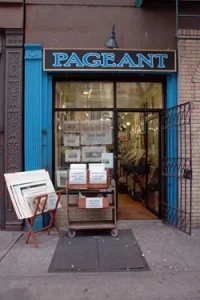
In the long, vanishing story of New York’s Book Row, one name continues to echo with quiet resilience — Pageant Book Store, now known as Pageant Print Shop. Founded in 1946 by Sidney B. Solomon and Henry “Chip” Chafetz, Pageant began as a modest secondhand bookshop on Fourth Avenue, a stretch once lined with dusty storefronts where bibliophiles hunted treasures and scholars unearthed forgotten texts. Over the decades, the shop’s story would mirror the rise, decline, and reinvention of New York’s antiquarian book world itself.
From Book Row beginnings
Pageant was born in a golden age of bookshops. After the Second World War, New York’s Fourth Avenue between Union Square and Astor Place became a legendary destination for book lovers. Dozens of stores, sometimes just a few feet wide, spilled their contents onto the sidewalk: literary remainders, first editions, rare bindings, and maps from another century. Amid this chorus of commerce and scholarship, Solomon and Chafetz opened their doors, combining a love of books with a practical sense for the trade.
Their shop quickly developed a reputation for reliability, intelligence, and range. By the 1950s, Pageant Book Company, as it was then known, was a hub for collectors, dealers, and academics. The New Yorker described it as “a sizable second-hand bookshop” and noted that the partners were already branching into publishing projects — including an ambitious facsimile of the Gutenberg Bible, a gesture that hinted at Pageant’s serious bibliographic spirit.
The transformation into Pageant Book & Print Shop
As the decades advanced, the neighborhood began to change. The cheap rents that had sustained Book Row started to climb, and many neighboring stores closed or moved uptown. By the 1970s, Pageant had shifted its focus to include maps, prints, and engravings — visual artifacts that spoke to the same audience of historians, travelers, and aesthetes who once came for rare books. The business renamed itself Pageant Book & Print Shop, signaling a broader scope but maintaining the scholarly integrity that had made its name.
Even as the city’s literary geography shifted and the last of Book Row’s bookstores disappeared, Pageant survived — not by resisting change, but by adapting to it.
Survival in a new century
By the late 1990s, the print and book trades faced a new challenge: the Internet. In 1999, Pageant’s final storefront as a full-scale bookshop closed its doors. Yet, in 2005, the business found new life. Reestablished as Pageant Print Shop, it reopened at 69 East 4th Street, in the East Village — a short walk from its original home. The new shop specialized in antique maps, prints, and engravings, offering carefully curated windows into the past for collectors, decorators, and historians alike.
Today, the store remains family-run, with Shirley and Rebecca Solomon, daughters of founder Sidney Solomon, continuing the legacy. The shop’s walls are lined with 19th-century lithographs, hand-colored maps, and early engravings — a paper museum of geography and art that feels more personal than institutional. It stands as both a survivor and a living link to New York’s once-fabled Book Row.
A legacy preserved
Pageant’s endurance is not just commercial; it is cultural. It preserves a way of seeing and handling knowledge that predates the digital age — when collectors felt the grain of paper and dealers remembered customers by name. The shop has even appeared in films, such as Hannah and Her Sisters, where its vintage character offered the perfect backdrop for Woody Allen’s Manhattan nostalgia.
More than a store, Pageant represents continuity: the bridge between the tactile world of rare books and the visual eloquence of historical prints. It reminds us that even as the city remakes itself, certain corners resist erasure. In the quiet rustle of a 200-year-old map, you can still hear the heartbeat of New York’s book trade — the sound of a world that refuses to vanish.
Content retrieved from: https://www.pageantprintshop.nyc/about-avenue and related historical sources.
